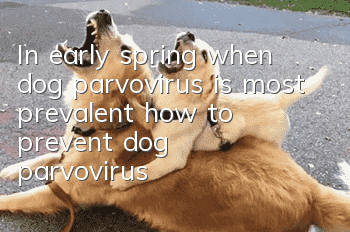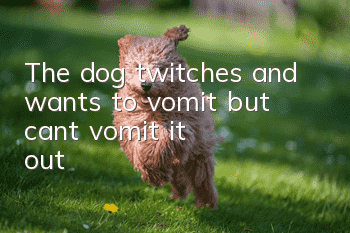In early spring, when dog parvovirus is most prevalent, how to prevent dog parvovirus?

I believe that many dog owners know something about parvovirus. Dogs suffering from parvovirus will be very painful, and the cure rate is relatively low. Dog parvovirus is most common in early spring, so everyone must take preventive measures to keep dogs away from parvovirus.
How is parvovirus spread?
Dogs can become infected after coming into contact with viruses in the environment. The virus is excreted in the feces of infected dogs and can persist stably in the environment for long periods of time. These viruses can be easily carried to many other places. A dog does not need to be exposed to feces that contains the virus to become infected. Parvovirus particles can live in the soil or outdoors for 5-7 months (longer in cold climates). If particles of these viruses get onto a dog's paws and hair and are then ingested, the dog can become infected with parvovirus.
Parvovirus most commonly infects puppies, but adult dogs that are unvaccinated or have compromised immunity may also be infected.
Parvovirus enters a dog’s body through the mouth. Dogs will show symptoms of infection after 3-7 days. In just a few days, an infected dog will have parvovirus in its feces and may infect other dogs around it. If the dog recovers, the symptoms gradually disappear, but the dog will continue to shed the virus in its feces during the illness and for several weeks after recovery.
Symptoms of canine parvovirus infection in dogs
Typical symptoms in puppies include: diarrhea, vomiting, loss of appetite and lethargy. The virus will quickly invade the normal cells of the affected dog, especially bone marrow cells and intestinal cells. Damage to bone marrow cells is manifested by a decrease in the number of white blood cells in the blood, followed by paralysis of the body's immune system. The symptoms of intestinal cell damage are: the intestinal lining is destroyed, and the body cannot digest and absorb nutrients normally. Symptoms include nausea, vomiting, and severe diarrhea. Bloody stools are more common and the smell is worse than normal stools. .
Eventually, as the disease takes its toll on the body, puppies will become very weak and severely dehydrated. When the intestinal wall is severely damaged and loses its barrier function to block bacteria, blood infections may occur, eventually causing sepsis. Sadly, many dogs do not survive parvovirus infection. Early detection and treatment are very important.
How to prevent dog parvovirus?
1. Vaccination
Vaccination is required. This is a necessary step to prevent parvovirus. It is best to give the dog a six-link vaccine, so that the resistance can be enhanced.
2. Avoid contact
When entering the pet hospital, you should not let your dog run around and sniff out dogs carrying parvovirus. You should also try to reduce contact with strange dogs when you go out.
3. Pay attention to your diet
To prevent microorganisms, pay more attention to the food you feed. Do not feed milk and the like, feed as little raw food as possible, and avoid feeding your dog chicken and duck bones. You can feed your dog some nutrients to help digestion.
4. Environmental disinfection
The living environment where dogs are raised should also be disinfected regularly, such as dog feeding bowls, water feeders, kennels, dog cages, toys, etc.
To disinfect, it is key to choose non-toxic and non-irritating disinfectants. Some disinfectants sold in the market, such as 84, ammonium chloride, peracetic acid, etc., are too irritating. People and dogs have already been infected before the poison is eliminated. No, some disinfectants are even so irritating that they can make people cry and reduce the sensitivity of pets’ sense of smell! After all, we can’t harm our pets and ourselves just to kill nasty bacteria!
Aineng Pet Sterilizing Spray can quickly kill a variety of viruses (canine distemper virus, canine parvovirus, canine coronavirus, influenza virus) and pathogenic bacteria (enteric disease bacteria, purulent bacteria, pathogenic yeast, hospital infection with common bacteria, etc.), the sterilization rate reaches 99%. It can also assist in the treatment of pet skin diseases and accelerate the healing of pet surface wounds. The pH value is 5.5~6.8, which is weakly acidic and close to the pH of the skin. It is safe, non-toxic, colorless and odorless.
Spraying Aineng Pet Sterilizing Spray in the space where people and pets coexist can effectively prevent the occurrence of epidemic diseases and common bacterial infections.
Aineng pet sterilizing spray is colorless, odorless, non-toxic and non-irritating. It can be licked by pets and has no sticky feeling. It is safe and secure! If you have puppies or pregnant dogs at home, you don’t have to worry about using it. It is green, environmentally friendly and non-irritating to both humans and dogs!
- Can dogs get arthritis? What causes dogs to get arthritis?
- How to help puppies increase their resistance? A must-read for novices!
- Diagnosis, prevention and treatment of periodontitis in dogs
- Diagnosis and treatment of kennel cough
- Paralysis rehabilitation methods for dogs
- Dog won't eat or drink, loses energy and vomits
- What can a dog eat to induce an abortion?
- What should I do if my dog keeps peeing when he's not at home?
- What are the causes of vomiting and diarrhea in dogs? Find the cause and prescribe the right medicine!
- Dog keeps coughing and foaming as if stuck



